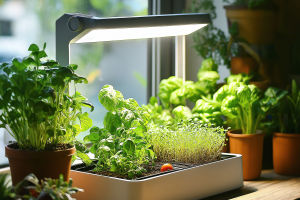Water is undeniably the lifeblood of plant growth. From the smallest seed to the tallest tree, every plant requires water to thrive.
But why is water so crucial for plant growth? Understanding the role water plays in plant life can help us appreciate the delicate balance of nature and emphasize why conservation efforts are more important than ever!
The Essential Role of Water in Photosynthesis
One of the most significant functions of water in plants is its role in photosynthesis. During this process, plants convert sunlight, water, and carbon dioxide into oxygen and glucose. Water, absorbed by the roots, is transported through the plant to the leaves, where it participates in this life-sustaining process. Without water, photosynthesis would grind to a halt, and plants would not be able to produce the energy needed for their growth and survival.
Water Transpiration and Nutrient Movement
Water also plays a critical role in the movement of nutrients throughout a plant. Transpiration, the process by which water evaporates from the plant’s leaves, creates a vacuum that pulls water and essential nutrients from the soil through the roots and into the plant’s system.
This process helps maintain the plant's hydration levels and ensures that nutrients like nitrogen, phosphorus, and potassium reach the plant’s cells. Without enough water, these nutrients would fail to reach vital areas, leading to stunted growth or even plant death.
Impact on Root Health and Soil Structure
Roots depend on water to remain turgid, meaning they must be kept firm and healthy to properly absorb nutrients. In dry conditions, roots can dry out and stop functioning, leading to a plant’s inability to access essential minerals and nutrients. Additionally, soil structure itself relies on the right balance of moisture. When soil is too dry, it can become compacted, making it harder for roots to find water. On the other hand, overly saturated soil can suffocate roots, leading to poor growth or root rot.
Water Stress: Signs and Consequences
Water stress can be a major issue for plants, especially in areas facing drought or irregular rainfall. Signs of water stress include wilting, yellowing of leaves, and reduced growth rates. When plants experience this type of stress, they prioritize survival over growth, often slowing down or halting reproductive processes.
If water scarcity continues, the plant can eventually die. This is particularly concerning in regions where agriculture is a primary source of food and income, highlighting the need for efficient water management systems.
The Climate Change Challenge
In the context of global climate change, water availability for plants is becoming increasingly unpredictable. Extreme weather patterns, such as prolonged droughts or heavy rains, are becoming more common, leading to inconsistent water supplies for plants.
Researchers are exploring new irrigation techniques, drought-resistant plant varieties, and better soil management practices to address these challenges. However, the relationship between plants and water remains fragile, and ensuring adequate hydration for plants is crucial for food security and biodiversity conservation.
Water Conservation for Plant Health
Given the integral role water plays in plant growth, it is essential to prioritize water conservation in our agricultural practices. Methods such as drip irrigation, mulching, and rainwater harvesting are becoming more popular as sustainable ways to conserve water while still supporting plant growth. Additionally, creating landscapes with drought-resistant plants can significantly reduce water consumption, helping communities adapt to changing climate conditions.
Lykkers, water is indispensable to the growth of most plants. From photosynthesis to nutrient transport, its absence or scarcity can have a devastating effect on plant life. As we face challenges like climate change and increasing global demand for resources, understanding and conserving water is more critical than ever. Protecting this vital resource will ensure the continued health of our ecosystems and the plants that sustain them!
Why Do Plants Need Water?
Video by Indoor Home Garden


